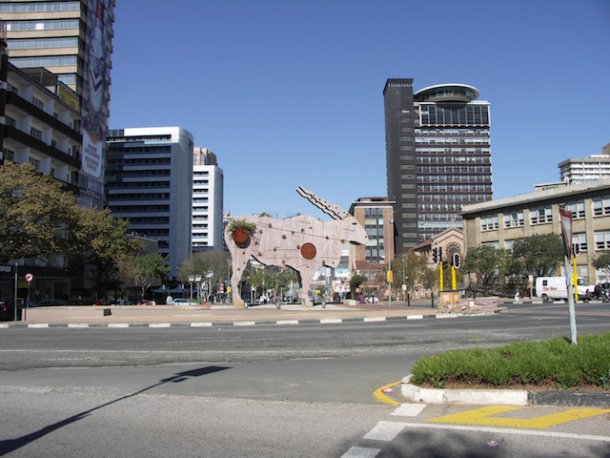A reconfiguração de Joanesburgo pela cena artística
Publicado15 Nov 2014

Houghton Kinsman parte da constação do crescimento económico e artístico de várias cidades africanas, socorrendo-se da expressão "afropolis", de Achille Mbembe que, com o termo, designa as grandes cidades transformadas em espaços cosmopolitas, reconfiguradas por fluxos complexos e assimétricos de ideias, bens, capitais e pessoas. Houghton Kinsma analisa, em particular, o caso de Joanesburgo, e a zona de Newtown, "nascida do desastre", por ter sido afectada por um enorme fogo no início do século XX.
By providing inspiration, preserving history and encouraging cultural participation, these cities have an increasingly multifaceted role in helping shape their country’s artistic discourse. The city’s ability to provide access to museums, its urban atmosphere and cultural, political and religious diversity are but a few of the factors that characterize a city’s influence on creative practice. Therefore, as these major African cities undergo renewal in order to provide the necessary infrastructure to position themselves as “global African cities,” questions inevitably arise over the consequent implications associated with urban redevelopment.
The dichotomy that exists between renewal and preservation within this discussion is a compelling phenomenon that can arguably be seen nowhere more pertinently than in Johannesburg. Long since considered a major economic and cultural city in South Africa, Johannesburg has and is undergoing continued urban renewal, especially in its arts precincts like Maboneng and Newtown. Mirroring major urban redevelopment in international cities such as Berlin, New York and London, Johannesburg is beginning to find success in reimagining its cultural landscape, in speaking with former Johannesburg mayor Mpho Parks Tau, it is “a city at work to remake itself.” As a result, Maboneng has blossomed into a – privately developed – arts mecca with lofts, chic cafés and independent movie theatres, and after numerous failed redevelopments, Newtown is finally beginning to realize its potential as the precinct awaits the R1.3 billion Newtown Junction shopping center. This reinvigoration – of Newtown in particular – which was conceptualized as early as 2005, has seemingly done wonders for the cultural and artistic climate of the city.
(...)
Playing host to numerous museums, galleries, and cultural spaces – most of which have either been initiated or developed in accordance with the renewal, Newtown now boasts institutions such as Museum Africa, the Goodman and Stevenson Galleries, Mary Fitzgerald Square and the Market Theatre. Additionally, the precinct has recently welcomed the Turbine Hall Art Fair – an event that arguably best embodies Newtown’s transformation, having developed out of renovations to the precinct’s iconic Turbine Hall. With the fair established in order to highlight local young emerging artists, it serves as a reminder of the reciprocal relationship between artist and city. Consequently, it is no surprise that the development of Newtown’s creative landscape continues to have a significant impact on those working in the city.
Joahannesburg and its Newtown: a city at work to remake itself, na Contemporary and
